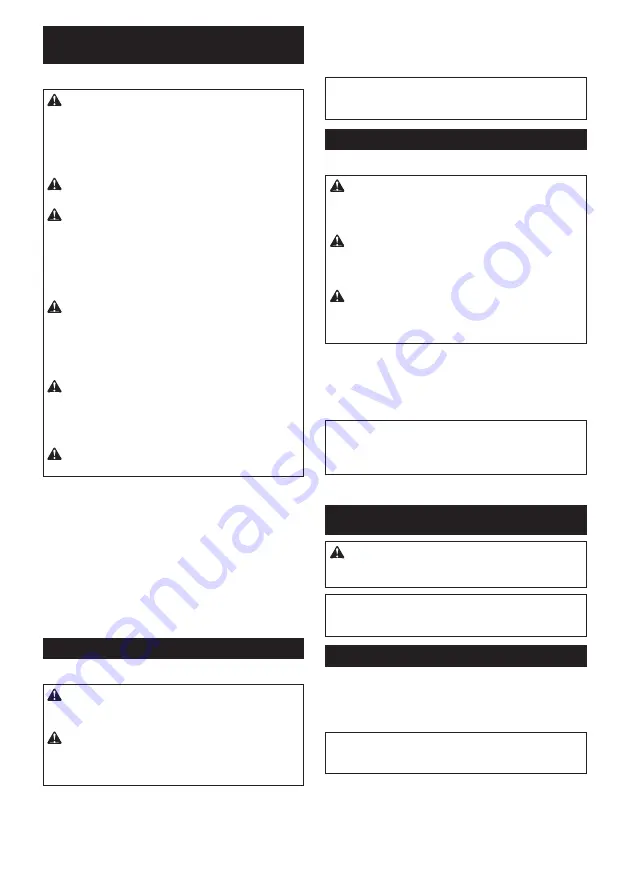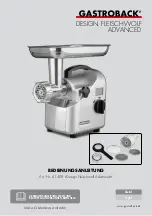
13 ENGLISH
Operation with abrasive cut-off /
diamond wheel
Optional accessory
WARNING:
When using an abrasive cut-off /
diamond wheel, be sure to use only the special
wheel guard designed for use with cut-off wheels.
(In some European countries, when using a diamond
wheel, the ordinary guard can be used. Follow the
regulations in your country.)
WARNING:
NEVER use cut-off wheel for side
grinding.
WARNING:
Do not “jam” the wheel or apply
excessive pressure. Do not attempt to make an
excessive depth of cut.
Overstressing the wheel
increases the loading and susceptibility to twisting
or binding of the wheel in the cut and the possibility
of kickback, wheel breakage and overheating of the
motor may occur.
WARNING:
Do not start the cutting operation
in the workpiece. Let the wheel reach full speed
and carefully enter into the cut moving the tool
forward over the workpiece surface.
The wheel
may bind, walk up or kickback if the power tool is
started in the workpiece.
WARNING:
During cutting operations, never
change the angle of the wheel.
Placing side pres-
sure on the cut-off wheel (as in grinding) will cause
the wheel to crack and break, causing serious per
-
sonal injury.
WARNING:
A diamond wheel shall be oper
-
ated perpendicular to the material being cut.
Mount the inner flange onto the spindle.
Fit the wheel / disc on the inner flange and screw the
lock nut onto the spindle.
►
Fig.18:
1.
Lock nut
2.
Abrasive cut-off wheel / dia
-
mond wheel
3.
Inner flange
4.
Wheel guard
for abrasive cut-off wheel / diamond wheel
For Australia and New Zealand
►
Fig.19:
1.
Lock nut
2.
Outer flange 78
3.
Abrasive
cut-off wheel / diamond wheel
4.
Inner
flange 78
5.
Wheel guard for abrasive cut-
off wheel / diamond wheel
Operation with wire cup brush
Optional accessory
CAUTION:
Check operation of brush by run
-
ning tool with no load, insuring that no one is in
front of or in line with brush.
CAUTION:
Do not use brush that is damaged,
or which is out of balance.
Use of damaged brush
could increase potential for injury from contact with
broken brush wires.
►
Fig.20:
1.
Wire cup brush
Unplug tool and place it upside down allowing easy
access to spindle.
Remove any accessories on spindle. Thread wire cup
brush onto spindle and tighten with supplied wrench.
NOTICE:
Avoid applying too much pressure
which causes over bending of wires when using
brush.
It may lead to premature breakage.
Operation with wire wheel brush
Optional accessory
CAUTION:
Check operation of wire wheel
brush by running tool with no load, insuring that
no one is in front of or in line with the wire wheel
brush.
CAUTION:
Do not use wire wheel brush that
is damaged, or which is out of balance.
Use of
damaged wire wheel brush could increase potential
for injury from contact with broken wires.
CAUTION:
ALWAYS use guard with wire
wheel brushes, assuring diameter of wheel fits
inside guard.
Wheel can shatter during use and
guard helps to reduce chances of personal injury.
►
Fig.21:
1.
Wire wheel brush
Unplug tool and place it upside down allowing easy
access to spindle.
Remove any accessories on spindle. Thread wire wheel
brush onto spindle and tighten with the wrenches.
NOTICE:
Avoid applying too much pressure
which causes over bending of wires when
using wire wheel brush.
It may lead to premature
breakage.
MAINTENANCE
CAUTION:
Always be sure that the tool is
switched off and unplugged before attempting to
perform inspection or maintenance.
NOTICE:
Never use gasoline, benzine, thinner,
alcohol or the like. Discoloration, deformation or
cracks may result.
Air vent cleaning
The tool and its air vents have to be kept clean.
Regularly clean the tool's air vents or whenever the
vents start to become obstructed.
►
Fig.22:
1.
Exhaust vent
2.
Inhalation vent
NOTE:
Do not loosen the screw on the name
plate cover. Otherwise the cover may be opened
accidentally.
►
Fig.23:
1.
Screw
To maintain product SAFETY and RELIABILITY,
repairs, any other maintenance or adjustment should
be performed by Makita Authorized or Factory Service
Centers, always using Makita replacement parts.














































